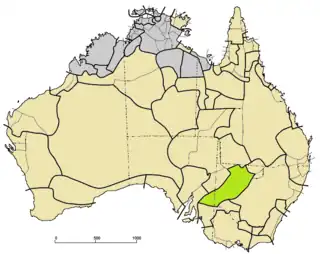Paakantyi language
The Paakantyi language, also spelt Paakantji, Barkindji, Barkandji, and Baagandji, and also known as the Darling language, is a nearly extinct Australian Aboriginal language spoken along the Darling River in New South Wales from present-day Bourke to Wentworth and including much of the back country around the Paroo River and Broken Hill. The people's and language name refers to the Paaka (Darling River) with the suffix -ntyi meaning "belonging to".[4] The speakers of the language are known as the Paakantyi (or variant spelling).
| Darling | |
|---|---|
| Paakantyi | |
| Native to | Australia |
| Ethnicity | Paakantyi, Kula (Kurnu), Naualko, Paaruntyi, Parrintyi, Wilyakali (Wiljali), Danggali, Maraura, Wanjiwalku |
Native speakers | 110 (2021 census)[1] |
Pama–Nyungan
| |
| Dialects |
|
| Language codes | |
| ISO 639-3 | drl |
| Glottolog | darl1243 |
| AIATSIS[3] | D12 |
| ELP | Paakantyi |
 The Darling language (green) among other Pama–Nyungan (tan) | |
 Paakantyi is classified as Critically Endangered by the UNESCO Atlas of the World's Languages in Danger | |
The major work on the Paakantyi language has been that of linguist Luise Hercus.[4]
Dialects
Dialects of Paakantyi include Southern Paakantyi (Baagandji, Bagundji), Kurnu (Kula), Wilyakali (Wiljagali), and Pantyikali-Wanyiwalku (Wanyuparlku, Bandjigali, Baarundji), Parrintyi (Barrindji), Marawara (Maraura). Bowern (2011) lists Gurnu/Guula as a separate language, though Hercus includes it because of its almost identical vocabulary.[5] Dixon adds several other names, some perhaps synonyms;[2] Bulaali (Bulali) may have been an alternative name for Wilyakali, but also for a different language, Maljangapa.[6]
However; Tindale (1940) mapped the 'Rite of Circumcision' border around Wanyiwalku separating it from the rest of Paakantyi - Tindale instead groups Wanyiwalku together with Maljangapa, Wadikali & Karenggapa of the Yarli language.
Current status
A 2012 report indicated that two people could speak the Darling language fluently,[7] while in the 2021 census, 111 individuals indicated that Paakantyi was spoken at home.
Phonology
References
- Australian Bureau of Statistics (2021). "Cultural diversity: Census". Retrieved 13 October 2022.
- Dixon, R. M. W. (2002). Australian Languages: Their Nature and Development. Cambridge University Press. p. xxxvi.
- D12 Darling at the Australian Indigenous Languages Database, Australian Institute of Aboriginal and Torres Strait Islander Studies
- Luise Hercus. Baagandji Grammar, ANU 1960; Paakantyi Dictionary (published with the assistance of AIATSIS, 1993)
- Luise Hercus. Paakantyi Dictionary (published with the assistance of AIATSIS, 1993)
- D11 Bulali at the Australian Indigenous Languages Database, Australian Institute of Aboriginal and Torres Strait Islander Studies
- Paul, Margaret (30 May 2012). "Funding sought for Aboriginal language classes". abc.net.au. Australian Broadcasting Corporation. Retrieved 1 June 2012.
- Andersen, Elena (2015). Development of a Learner's Grammar for Paakantyi (Thesis). University of Sydney.